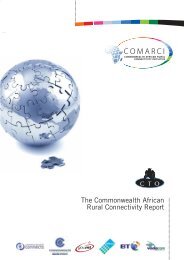Guide to measuring information and ... - unesdoc - Unesco
Guide to measuring information and ... - unesdoc - Unesco
Guide to measuring information and ... - unesdoc - Unesco
Create successful ePaper yourself
Turn your PDF publications into a flip-book with our unique Google optimized e-Paper software.
ED45 Proportion of learners enrolled in grades where basic computer skills (or computing) are currently<br />
taught (for ISCED levels 1-3 )<br />
Definition:<br />
Number of learners enrolled in grades where basic<br />
computer skills (or computing) are taught during the<br />
current academic year, expressed as a percentage of<br />
the <strong>to</strong>tal number of learners for ISCED levels 1-3.<br />
Data requirement:<br />
(LBCL) Number of learners enrolled in grades where<br />
basic computer skills (or computing) are currently taught<br />
for ISCED levels 1-3.<br />
(refer <strong>to</strong> questionnaire item E.1.4)<br />
(L) Number of learners enrolled at ISCED levels 1-3.<br />
(refer <strong>to</strong> questionnaire item E.1)<br />
Formula:<br />
3<br />
<br />
h1<br />
Where:<br />
LBCL<br />
3<br />
<br />
h1<br />
LBCL t<br />
h<br />
L<br />
t<br />
h<br />
t<br />
h<br />
* 100<br />
- 77 -<br />
Purpose:<br />
To measure learners’ participation in basic computer<br />
skills (or computing) programmes in primary <strong>and</strong><br />
secondary education<br />
Method of collection:<br />
Administrative data collection through annual school<br />
census (or extract data from school records).<br />
Data source(s):<br />
Statistical unit of the Ministry of Education or,<br />
alternatively, the national statistical office.<br />
= Number of learners enrolled in grades where basic computer skills (or computing) were taught at<br />
level of education h in school-year t<br />
L t<br />
= Number of learners enrolled at education level h in school-year t<br />
h<br />
Analysis <strong>and</strong> interpretation:<br />
A high percentage or value for this indica<strong>to</strong>r reveals a<br />
high degree of learner participation in basic computer<br />
skills (or computing) programmes in primary <strong>and</strong><br />
secondary schools, <strong>and</strong> of countries’ achievements in<br />
integrating basic computer skills in primary <strong>and</strong><br />
secondary school curricula.<br />
Besides its use in international comparison, this indica<strong>to</strong>r<br />
can be calculated <strong>and</strong> analysed by ISCED levels <strong>and</strong><br />
grades, geographical regions, urban/rural areas <strong>and</strong><br />
public/private schools.<br />
Methodological <strong>and</strong> definition issues or<br />
operational limitations:<br />
Whereas indica<strong>to</strong>r ED9 <strong>and</strong> ED9bis informs about<br />
existing policies <strong>and</strong> curricula <strong>to</strong> introduce basic<br />
computer skills in various grades of primary <strong>and</strong><br />
secondary education, ED45 reflects the current state<br />
of implementation of this policy goal.
















